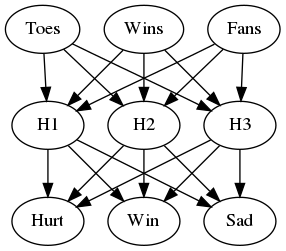Okay, but what about this deep-learning stuff?
Table of Contents
Imports
From Python
from typing import List
From Pypi
from graphviz import Digraph
import numpy
Typing
This is to develop some type hinting.
Vector = List[float]
Matrix = List[Vector]
What is this about?
I previously looked at a model with multiple inputs and outputs to predict whether a team would win or lose and how the fans would feel in response to the outcome. Now I'm going to stack the network on top of another one to 'deepen' the network.
graph = Digraph(comment="Hidden Layers", format="png")
# input layer
graph.node("A", "Toes")
graph.node("B", "Wins")
graph.node("C", "Fans")
# Hidden Layer
graph.node("D", "H1")
graph.node("E", "H2")
graph.node("F", "H3")
# Output Layer
graph.node("G", "Hurt")
graph.node("H", "Win")
graph.node("I", "Sad")
# Input to hidden edges
graph.edges(["AD", "AE", "AF",
"BD", "BE", "BF",
"CD", "CE", "CF",
])
# Hidden to output egdes
graph.edges(["DG", "DH", "DI",
"EG", "EH", "EI",
"FG", "FH", "FI",
])
graph.render("graphs/hidden_layer.dot")
graph

These networks between the input and output layers are called hidden layers.
Okay, so how do you implement that?
It works like our previous model except that you insert an extra vector-matrix-multiplication call between the inputs and outputs. For this example I'm going to do it as a class so that I can check the hidden layer's values more easily, but otherwise you would do it using matrices and vectors.
class HiddenLayer:
"""Implements a neural network with one hidden layer
Args:
inputs: vector of input values
input_to_hidden_weights: vector of weights for the first layer
hidden_to_output_weights: vector of weights of the second layer
"""
def __init__(self, inputs: Vector, input_to_hidden_weights: Vector,
hidden_to_output_weights: Vector) -> None:
self.inputs = inputs
self.input_to_hidden_weights = input_to_hidden_weights
self.hidden_to_output_weights = hidden_to_output_weights
self._hidden_output = None
self._predictions = None
return
@property
def hidden_output(self) -> Vector:
"""the output of the hidden layer"""
if self._hidden_output is None:
self._hidden_output = self.vector_matrix_multiplication(
self.inputs,
self.input_to_hidden_weights)
return self._hidden_output
@property
def predictions(self) -> Vector:
"""Predictions for the inputs"""
if self._predictions is None:
self._predictions = self.vector_matrix_multiplication(
self.hidden_output,
self.hidden_to_output_weights,
)
return self._predictions
def vector_matrix_multiplication(self, vector: Vector,
matrix: Matrix) -> Vector:
"""calculates the dot-product for each row of the matrix
Args:
vector: input with one cell for each row in the matrix
matrix: input with rows of the same length as the vector
Returns:
vector: dot-products for the vector and matrix rows
"""
vector_length = len(vector)
assert vector_length == len(matrix)
rows = range(len(matrix))
return [self.dot_product(vector, matrix[row]) for row in rows]
def dot_product(self, vector_1:Vector, vector_2:Vector) -> float:
"""Calculate the dot-product of the two vectors
Returns:
dot-product: the dot product of the two vectors
"""
vector_length = len(vector_1)
assert vector_length == len(vector_2)
entries = range(vector_length)
return sum((vector_1[entry] * vector_2[entry] for entry in entries))
Let's try it out
The Input Layer To Hidden Layer Weights
| Toes | Wins | Fans | |
|---|---|---|---|
| 0.1 | 0.2 | -0.1 | h0 |
| -0.1 | 0.1 | 0.9 | h1 |
| 0.1 | 0.4 | 0.1 | h2 |
input_to_hidden_weights = [[0.1, 0.2, -0.1],
[-0.1, 0.1, 0.9],
[0.1, 0.4, 0.1]]
The Weights From the Hidden Layer to the Outputs
| h0 | h1 | h2 | |
|---|---|---|---|
| 0.3 | 1.1 | -0.3 | hurt |
| 0.1 | 0.2 | 0.0 | won |
| 0.0 | 1.3 | 0.1 | sad |
hidden_layer_to_output_weights = [[0.3, 1.1, -0.3],
[0.1, 0.2, 0.0],
[0.0, 1.3, 0.1]]
Testing it Out
toes = [8.5, 9.5, 9.9, 9.0]
wins = [0.65, 0.8, 0.8, 0.9]
fans = [1.2, 1.3, 0.5, 1.0]
expected_hiddens = [0.86, 0.295, 1.23]
expected_outputs = [0.214, 0.145, 0.507]
first_input = [toes[0], wins[0], fans[0]]
network = HiddenLayer(first_input,
input_to_hidden_weights,
hidden_layer_to_output_weights)
hidden_outputs = network.hidden_output
expected_actual = zip(expected_hiddens, hidden_outputs)
tolerance = 0.1**5
labels = "h0 h1 h2".split()
print("|Node | Expected | Actual")
print("|-+-+-|")
for index, (expected, actual) in enumerate(expected_actual):
print("|{} | {}| {:.2f}".format(labels[index], expected, actual))
assert abs(expected - actual) < tolerance
| Node | Expected | Actual |
|---|---|---|
| h0 | 0.86 | 0.86 |
| h1 | 0.295 | 0.29 |
| h2 | 1.23 | 1.23 |
outputs = network.predictions
expected_actual = zip(expected_outputs, outputs)
tolerance = 0.1**3
labels = "Hurt Won Sad".split()
print("|Node | Expected | Actual")
print("|-+-+-|")
for index, (expected, actual) in enumerate(expected_actual):
print("|{} | {}| {:.3f}".format(labels[index], expected, actual))
assert abs(expected - actual) < tolerance
| Node | Expected | Actual |
|---|---|---|
| Hurt | 0.214 | 0.214 |
| Won | 0.145 | 0.145 |
| Sad | 0.507 | 0.506 |
Okay, but can we do that with numpy?
def one_hidden_layer(inputs: Vector, weights: Matrix) -> numpy.ndarray:
"""Converts arguments to numpy and calculates predictions
Args:
inputs: array of inputs
weights: matrix with two rows of weights
Returns:
predictions: predicted values for each output node
"""
inputs, weights = numpy.array(inputs), numpy.array(weights)
hidden = inputs.dot(weights[0].T)
return hidden.dot(weights[1].T)
One thing to watch out for here is that the dot product won't raise an error if you don't transpose the weights, but you will get the wrong values.
weights = [input_to_hidden_weights,
hidden_layer_to_output_weights]
outputs = one_hidden_layer(first_input, weights)
expected_actual = zip(expected_outputs, outputs)
tolerance = 0.1**3
labels = "Hurt Won Sad".split()
print("|Node | Expected | Actual")
print("|-+-+-|")
for index, (expected, actual) in enumerate(expected_actual):
print("|{} | {}| {:.3f}".format(labels[index], expected, actual))
assert abs(expected - actual) < tolerance
| Node | Expected | Actual |
|---|---|---|
| Hurt | 0.214 | 0.214 |
| Won | 0.145 | 0.145 |
| Sad | 0.507 | 0.506 |
Okay, so what was this about again?
This showed that you can stack networks up and have the outputs of one layer feed into the next until you reach the output layer. This is called Forward Propagation. Although I mentioned deep-learning in the title this really isn't an example yet, it's more like a multilayer perceptron, but it's deeper than two-layers, anyway.